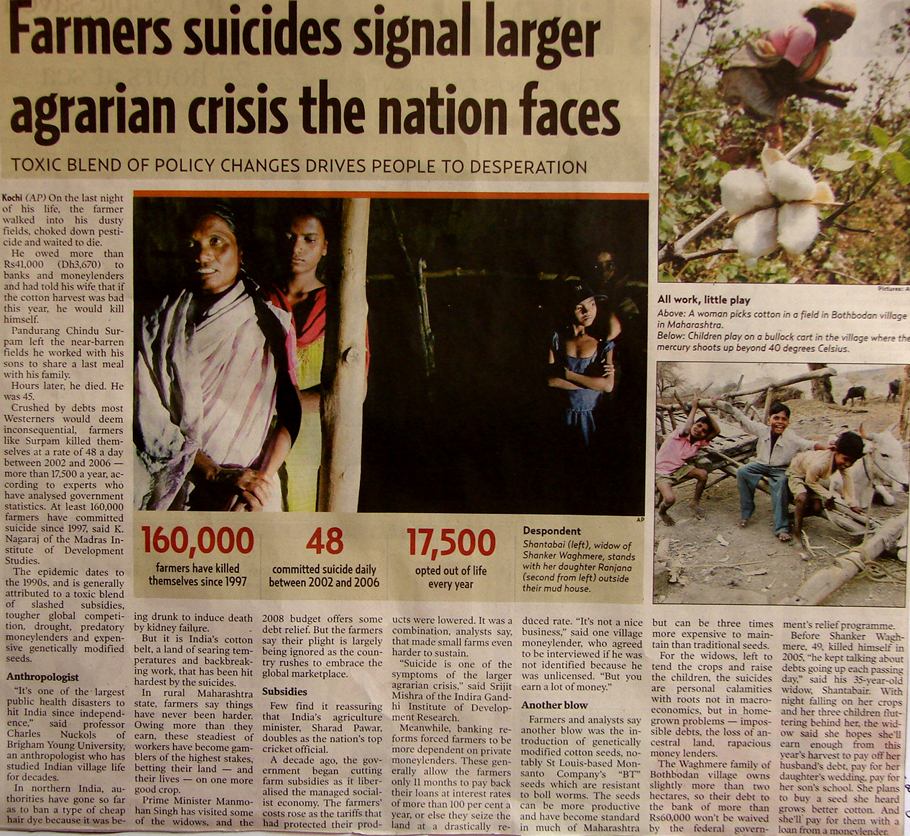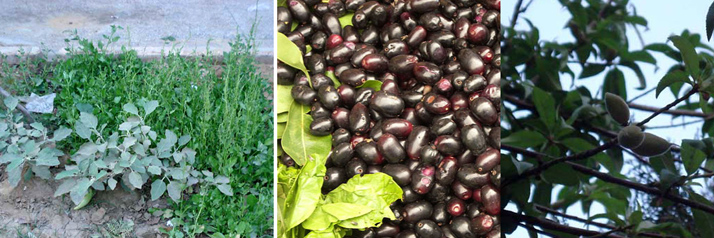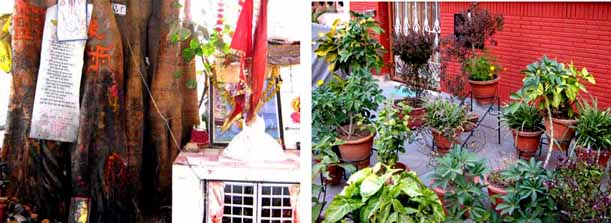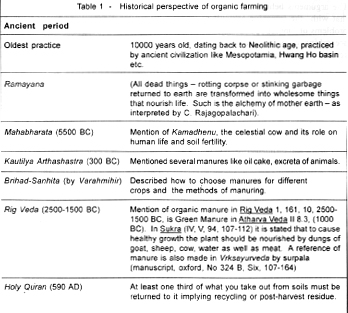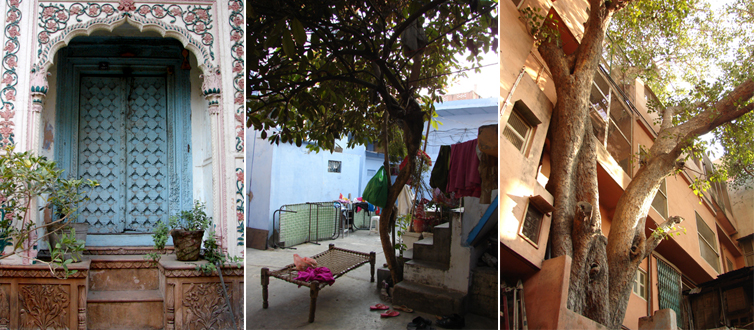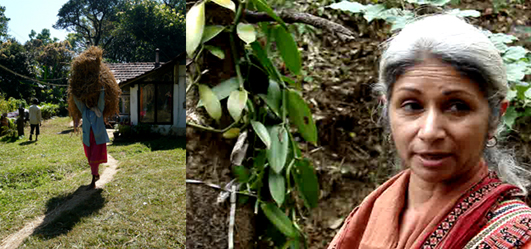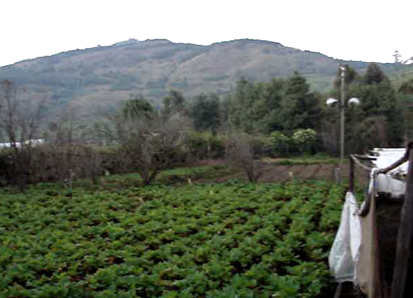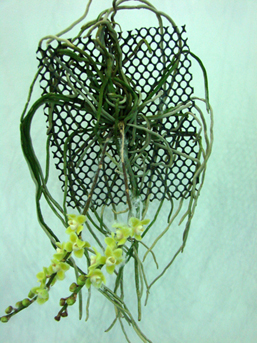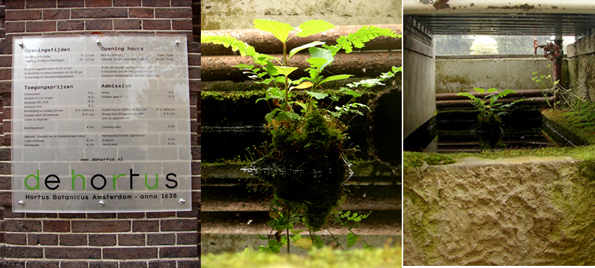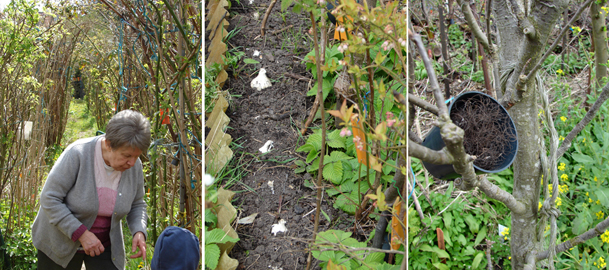Table of Contents
Site visits and Surveys
These notes form a part of sanjeev shankar's research, which is summarised in his research report
India
Though India has been known for its strong traditional agricultural methods, it is facing one of the worst agrarian crisis since independence. More than 160,000 farmers have committed suicide since 1997, with the cotton belt of Maharashtra the worst hit. Impossible debts, loss of ancestral land, expensive genetically modified seeds, large scale dependence on rain, reduction in farm subsidies, unfriendly banks, liberalised economies and moving away from traditional farming practices are some of the contributory factors. Today, the country faces a serious challenge in balancing its rush to embrace the global marketplace with preserving and nurturing its farms. Agriculture, on which 70 percent of India's people still depend for survival, is growing at a dismal rate of 2.8 percent. According to a recent report released by the Assessment of Agricultural Knowledge, Science and Technology for Development(IAAKSTD), an inter-governmental entity initiated by the World Bank and the United Nations Food and Argicultural Organization(FAO), industrial agriculture boosts yields in the short term but leads to the long-term destruction of land on which agriculture depends and of the social and environmental context with which it is intimately linked. The north Indian state of Punjab, is testimony to this. Hailed as the poster child of green revolution, today it is on the verge of collapse with pesticide poisoning, soil salinity, fertiliser run off, drug addiction and high cancer rates. India is no longer able to keep pace with its growing population and the demands of the emerging middle class(18 million people added each year). Demographically, more than 66 percent of Indians still reside in rural areas. Not surprisingly, the emphasis has always been on rural agriculture. This dominant rural demographic, will continue till 2050 and is an important difference between India and Europe, which has a reverse population distribution in terms of percentage of people residing in cites. Despite growing pressure from transnational corporations like Cargill, Monsanto, Syngenta, Wal-Mart and Carrefour, as well as Indian giants such as Reliance, Bharti and Tata who want to encourage intensive industrial agriculture; India would do better to look toward successful ventures in community-based natural farming, such as those undertaken by the Centre for Sustainable Agriculture.1)Further, the positive contribution that production within the cities can make, has hardly been acknowledged in India and can thus be drafted into a national policy. For more details on this please see the analysis of peri-urban agriculture in India.
New Delhi, which is the capital of India has a population of over 15 million. A couple of decades ago the area surrounding the city was mostly agricultural. Today, the city is increasingly in the midst of an urban sprawl. Delhi has over 40% of it citizens living in slum like conditions and over the past decade they are being systematically thrown out. The river banks too were till recently a site for the poor. As demand for scarce land rises, there is an ongoing change in the demographics of residential areas. After a concerted city action in early nineties over 7500 hectares of forest are now legally protected in the city, and through another law, tree cutting needs special permission. Similarly Non Governmental Organisations along with the courts have ensured the conversion of public transport from diesel to Compressed Natural Gas, a cleaner fuel. At the social and physical level, Delhi remains a historical, multi-layered fragmented city. Such multi layered city character is common in India and creates a complex urban dynamic. In Delhi, apart from the ridge forest which is the capital's green lung, substantial green stretches are seen in educational zones, military campuses and religious institutions. Home gardens are common with the role of the 'maali'(gardener) crucial in maintaining the gardens. Commonly grown plants include green chilis, tomatoes, beans, papaya, grapes, jamun(or jamblang), cucumber, bananas, guavas, money plants, marigold and mangoes. A lot of these edibles are consumed within the household or within the local community. There is hardly any attempt to process, package or value add the produce, which are often sold on the streets. It is not uncommon to see vendors selling seasonal produce from nearby villages too. Organic gardens are not common within the city realms.
Some pointers related to organic farming in Delhi:
- Small-scale organic farming initiatives near the capital are providing clues on how to reap healthy profits from the land.
- Around New Delhi, free-range and organic goods from newcomers are showing that money can be made by growing specialty products that consumers are willing to pay more for. High-value crops which include fruits, vegetables, milk, poultry products and fish are the focus and not cereals. A French Farm in Gurgaon, a suburb of New Delhi known mainly for its call centres, raises thousands of free-range Peking and Muscovy ducks on feed that is free of pesticide and antibiotics. A lot of these products are sold to high end hotels and not to the common man on the streets.
- A more recent start-up, Heritage Health Food, delivers boxed organic food grown on 80 acres of leased land. The two-year-old firm makes 200 to 300 deliveries a week, priced at between 200 and 400 rupees (five to 10 dollars) depending on weight, and is still to become common with the middle class household.
- The Indian Council of Agricultural Research has developed standards for organic exports, and mandatory domestic standards are in the works. This will make it easier and cheaper for farmers to get the kind of accreditation that is recognised abroad. According to S. Dave,from the agricultural export council APEDA, “Organic exports are growing by 100 percent a year. Many people are still going in for traditional farming, which is mostly organic. Four million hectares (9.8 million acres) of land are now devoted to certified organic farming for export, including of mangoes, spices and nuts.”
- In New Delhi, the Navdanya outlets started by environmentalist Vandana Shiva, sources organic oils and lentils from small farmers. Through their direct market initiative, they also bring different varieties of rice, wheat, flour, dals, rajma, spices, edible oils, breakfast cereals, natural sweeteners, millets, cookies, jams, pickles, squashes, culinary herbs etc. Recently they have partnered with Hindustan Petroleum Corporation Ltd (HPCL) to avail an existing network of HPCL centres which double up as organic outlets.2)
- One of the country's best known brands, FabIndia, which began four decades ago selling clothes that drew on craft traditions, has recently branched into organic spices, teas and granola. Introduced in 2004 under the brandname of Fabindia Organics, FabIndia has successfully diversified and positioned its organic range. While it is becoming a source of huge profits for the group, it is also creating an interest and strong market for traditional agricultural techniques.3)
- Elsewhere in India, more than 5,000 farmers in 250 villages of Surat in Gujarat have switched over to organic farming, according to agro-expert Chandrakanth Mandavia of the Abhyuthan Gram Vikas Mandal, a Surat-based organisation. The most common crops are mushrooms and mangoes.
- Certain religious institutions in India, like ISKCON(International society for Krishna conciousness) lay special emphasis on organic farming and have a successful model to train people in bio-dynamic farming in their national centre in Karnataka. This is part of the Bio-Dynamic association of India(BDAI).4)
For more details about organic farming around Delhi, please click on the links below:
- ciks_workreport_2007.pdf(2006-2007 CIKS:Centre for Indian Knowledge Systems report on organic farming in india)
Organic farming in India
Organic farming is gathering momentum all over the globe and is currently practiced in more than 100 countries. Although the term 'organic farming' is getting popularity in recent times, it was initiated 10000 years back when ancient farmers started cultivation depending on natural sources only. There is brief mention of several organic inputs in India's ancient literatures like Rigveda, Ramayana, Mahabharata, Kautilya Arthasashthra etc. In fact, organic agriculture has its roots in traditional agricultural practices that evolved in countless villages and farming communities over the millennium. For more details on this topic click on organic farming in India.
Chandni Chowk, Delhi
Chandni Chowk is a dense urban settlement, designed in the 15th century by the mughal emperor Shah Jahan. The place has been a thriving epicentre of largescale trade in north India for 600 years. In his search for 'green' spots in this place, the researcher witnessed how religion plays a crucial role in creating a narrative, which brings much needed spiritual and ethical base in wake of growing pressure from real estate groups. During a visit to a 15th century traditional haveli Sanjeev saw a huge 'peepal' tree. ('Peepal' is a local Indian tree which is worshipped by Hindus) The tree has remained there for over 300 years with changes in built form happening all around it. Further inquiry results in more informal courtyards and smaller, personal touches of green: marigold flowers in front of the temple, the small 'jamun' tree in the court yard, 'tulsi', 'kadi patta' and money plants. Marigold flowers are offered during daily prayers in hindu temples while the 'tulsi' plant (holy basil) is a herb and has been traditionally worshipped in hindu households. A visit to one of the oldest jain temples further gives an insight into how most religions have had an approach based on self-regulation. A priest informed the researcher that 'Jain monks are like grazing cattle;they never take too much from one place or person. They take small amounts and then move onto the next spot.'
Tata Energy Research Institute, Forestry department, New Delhi and Foundation of Revitalisation of local health traditions, Bangalore
Community outreach program of home herbal gardens5) in Delhi using the following plants:
- Holy basil or Rama tulsi. The plant is used in the treatment of cough, cold, bronchitis, diarrhea and dysentery.
- Stevia. The processed leaves yield a natural sweetener which is a substitute for table sugar, safe for diabetics, as it does not affect blood sugar levels.
- King of biters or Kalmegh. The plant is used for treating dysentery, cholera, diabetes, influenza, bronchitis, piles, gonorrhoea, and snake venom poisoning.
- Asparagus or Shatavari. The plant part is used for treating nervous disorders, tumours, scalding of urine, throat infections, tuberculosis and bronchitis.
- Tinospora Gulancha or Giloy. The plant is used in the treatment of fever, jaundice, thirst, loss of appetite, urinary diseases, and skin ailments.
- Aloe or Gwar Patha. The plant part is used to heal wounds, ulcers, and burns. It is also used to treat liver and spleen ailments.
- Winter Cherry or Ashwagandha. The plant part is used in Ayurvedic medicines to treat ulcers, fever, cough, rheumatism, leucoderma and to restore memory loss.
- Lemon grass or Gandhatrina. This herb is a stimulant (increases physical or nervous activity), diaphoretic (increases perspiration), and anti-spasmodic (reduce spasm).
- Mint or Pudina. The infusion of leaves is used in the treatment of rheumatism. Oil from the plant; know as Japanese Mint Oil is used to cure fever.
- Vasaka or Adusa. Used for treating bronchitis, asthma, and dental ailments.6)
This outreach program in urban realms would also lend to revitalising traditional Indian medicinal plant knowledge and create independent seed banks. For more details click on the following articles:
Gurukula Botanical Sanctuary, Kerala
Spread over 55 acres, the Gurukula Botanical Sanctuary is a garden of wild plant species grown at the edge of a large rainforest reserve in the Western Ghat Mountains of Kerala, India. Dedicated to conservation and education, the Sanctuary is run by a small group of resident gardeners, naturalists and educators, and supported by a wide circle of well-wishers. Founded in 1981, the Sanctuary restores endangered species and habitats in a highly fragmented landscape, where only a fraction of original forest remains and much of the native flora has been tragically and sometimes deliberately extracted or “cleaned up” for human use. Conservation in this district of Wayanad, where the original settlers were small migrant farmers with immediate survival needs, is an exceptionally challenging job.
Director, Suprabha Seshan elaborates, “The focus here is to find creative, localized and effective ways to restore natural places. Termed as ecosystem gardening, this involves working closely with plants and their environments: tending, cultivating, growing, reseeding, intervening and leaving as much wild space alone. There is clear evidence that the forests will return if we give them a chance.” It’s heartening to know that, “over time, the distinction between healing areas and the natural forest has diminished. Both, species diversity and forest structure have made a comeback in areas that had been completely devastated.” Apart from conservation and education the work at the sanctuary includes: developing horticultural and conservation skills in local young women; habitat restoration and forest recovery; research in biodiversity, forest ecology, plant taxonomy; and sustainable agriculture and integrated land use to grow the forest farm.
The results in Gurukula are due to a clear understanding and acceptance of the complexity of the problem and of the diversity of techniques required, including detailed long-term observation, scientific knowledge, sound horticultural practice, rigorous experimentation and excellent team work. Over the years a broad knowledge base of 120 plant families covering ecology, biogeography, taxonomy, plant pathology and horticulture has been developed and this has inspired not just the local and national communities but also many international organizations.
For complete article about the Sanctuary, please click on soliloquy_gurukula.pdf
Rainforest Retreat, Karnataka
The Rainforest Retreat7) is an eco-lodge located on an Organic Spice Plantation (MOJO Plantation) nestled in the heart of the Western Ghats (in Kodagu district of southern Karnataka). Founded by Dr. Sujata, a botanist and Anurag Goel, a molecular biologist turned organic farmer, their business model is based on sharing the nuances of organic farming with the visitors apart from selling locally grown cardamom, cinnamon, vanilla, pepper and coffee. Their methods are based on the following prnciples aimed at working toward generating a sustainable agri-ecosystem in the fragile environment:
- Maintaining the forest canopy to conserve the top soil and replenish it with compost.
- Recycling all forms of materials generated on the farm
- Creating conditions favoring the survival of other components of the farm-field(agri-) ecosystem, like the predatory and microbial populations of the soil.
- Emphasizing on multiple-cropping systems
- Integrated pest management using medicinal plants with insect repellant properties.
- Identifying and usng non-toxic(plant) sustitutes for chemically synthesized fertilizers and pesticides only under conditions of extreme necessity.
The retreat has a striking method of composting weeds, particularly the foliage of leguminous plants, plants with insect repellant properties, organic farm wastes, cattle and poultry manure, and oil cakes. With the addition of a mixture of natural isolates of 'good' bacteria(EM, Effective Microorganisms) that break down organic matter both anaerobically and aerobically, rapid solubilizing of phosphates, nitrates and other nutrients into compost occurs. The time taken for making this excellent quality compost('bokashi'), with this method has reduced to 6-8 weeks as against 4-6 months before. This technology was originally developed by Professor Teruo Higa of Japan to complement natural farming techniques.
Under the push for integrated pest management to counter stemborers and other lepidopteran pests, the retreat uses a decoction made out of plants from surrounding areas often identified as 'weeds'. These include pongamia, annona, lantana, nicotiana, capsicum, ocimum and few others. Further, these plant extracts are not toxic or repellant to spider populations and by introducing native strains of a soil-borne fungus, trichoderma sp. through compost over the years, there has been significant reduction in the damage caused by the pathogen phytophthora sp. to cardamom, ginger and pepper.
Beaulah Farm, Tamil Nadu
Tucked away in a picturesque pocket of the Nilgiris in South India, Beulah Farm provides the chance visitor a rare personal treat in the state of Tamil Nadu. The place which was founded by Eapen Jacob, does not fall within the usual tourist circuit. One may stumble upon it in the course of meandering walks one usually takes in the hills. Around the cottage, what looks like a wild tangle of a garden, each shrub, plant and bush makes up the herb garden which has been lovingly nurtured and tended to by Eapen, who plays music to his plants every day! From the three different kinds of basil and four different kinds of mint, the rosemary, thyme, sage and parsley. Passion fruits, Malta oranges, lemons make the fruit orchard, along with the strawberry patch. All of these go into making wines, liqueurs, tart marmalades, rhubarb jam and preserves made in a unique way in Sandalwood barrels on the farm. 23 different varieties of Rose wine (including a green and a black rose), guava squash, mint liqueur and a horse radish wine are some of his most popular products, all made in an organic way perfected over the last 25 years. In Jacob's own words, 'Not a grain of yeast or any chemical has gone into the brewing of the wines. We even make our own fertilizers and a gaggle of geese act as his pest control measure.' The liquid organic manure made from sheep and fowl droppings is high in nitrogen and perfect for all the farm produce except for strawberries as it results in extensive leaf growth.
Krac-Á-Dawna Organic Farm, Karnataka
Founded by Juli and Vivek Cariappa, KRAC-A-DAWNA is an evolving farm nestled deep within rural Karnataka. It is an important member of the OFAI(Organic Farmers association of India) and has for long searched for practical solutions to daily problems. From home-schooling to manure-teas and bio-gas there are no fixed rules here. Ths is an interesting example in self-learning and re-learning about believing in one's instincts and defying a modern developmental process that relies too heavily on mass production and a rigid definition of “civilization”. Self-reliance figures prominently in the farms thinking and its founders take a stand on issues ranging from genetically modified seeds to alternative markets, from child education to small- farm organic certification. Nothing leaves the farm in raw form and from natural dyes and cotton to wild honey, cinnamon, pepper and sesame butter, the farm produce has become an important revenue source. Lately, the farm has started developing its expertise in Bio-dynamic farming and trains registered farmers in the same.
Project Deep Fields
An interesting proposal in the 'Green Cities and Open Ideas' category by Krishna Balakrishna from UC Berkeley and Ganesh Mohan, IIT Chennai. The study proposes to create a Deep Fields Organic Farmers Co-operative which connects the problem of improper garbage disposal in Indian cities to providing an impetus for organic farming in urban edges. The project stems from a desire to initiate a program that is financially viable, ecologically sustainable, and socially conscious. Further, the ideas proposed are a complete cycle of events rather than discrete units of action.
In brief the proposal consists of the following steps: 1. Utilize urban organic waste for generating compost. 2. Promote organic farming of fruits and vegetables using this compost, in villages near urban centers 3. Set up a viable model of distributing the produce to small scale retail units in the cities. 4. Set up a points system by which the citizens who contribute organic waste get discounts on their shopping at these small scale retail units. 5. Urban waste that is generated enters the above described cycle once again.
The complete report can be seen here:
"RUrbanism": The Goa 2100 Project
“RUrbanism” is the sustainable integration of rural and urban communities. It is a sophisticated new set of design principles and practices governing land use, energy, transportation, governance, and all aspects of economic, ecological, and social development for a major city. The term “RUrbanism” was introduced by the designers of “Goa 2100,” a critical breakthrough planning project for the capital city of Panjim, in the Indian state of Goa. Goa 2100 won a Special Jury Prize in the International Sustainable Urban Systems Design competition (Tokyo, 2003). The project is a model of RUrbanism in practice, and it introduces a wide array of new design concepts and analytical tools to support sustainability planning and a transition to sustainability.8)
The project started with Comprehensive Data-Gathering and Benchmarking and invents a great deal of new methodology. The empirical study of built form and settlement structure enabled the group to create new quantitative models, including a “Resource Security Index” for water and energy needs. When it came to the buildings themselves, the group used the design principles of Christopher Alexander (A Pattern Language) and extended them using integrated life-cycle analysis and other methods. A new set of principles for sustainable infrastructure design was developed for the static (long-lasting) and dynamic (fast-changing) elements of the city. The analysis of the entire “temporal economy” of the city and region led to a key discovery: that time should be considered as an additional resource when considering the financing of a transition. Using a time use budget, attention is brought to the fact that how people spend their time is a key element of both their quality of life, and the sustainability of a society. The Goa 2100 model appears to be the first sustainability analysis of the time-use of an entire city.
This extensive exercise in quantitative analysis and modeling was the foundation for a reimagining of the city of Panjim, following the newly framed principles of “RUrbanism.” These were defined by the design team in terms of three overall goals; seven “organizing principles for sustainability”; five “strategies for land-use management”; six “tactics to manage physical stocks and flows”; and a set of descriptions for the urban form that they grouped under the heading, “A Dynamic Fractal Morphology.” RUrbanism involves transforming the city into a symbiotic partner with both nature and rural culture and a net producer of resources and value, rather than a parasitic consumer.9)
International Plants Expo, Dubai
Held from March 04-06, 2008 IPM DUBAI10) was a focussed trade exhibition for the green industries in the middle east and the Indian Subcontinent. One of the products, nature pot by NAPAC, a Zurich based company specialising in the development and manufacturing of products made of raw materials from renewable resources: is suitable for outdoor and indoor plant cultivation. A smart kit which comes with seeds and organic fertiliser, it rates highly on bio-innovation.11)
Hortus Botanicus Amsterdam, Netherlands
Established in 1663, the hortus is one of the oldest botanic gardens in the world with more than 6000 plants from all over. What started out as a medicinal herb garden, the hortus grows only pure plant species, as they are found in nature. It is also the first botanic garden in the Netherlands to display the molecular systemics of plants to everyone and continues to organize various cultural, educational and botanical activities through out the year.12)
Gilbert's Eco-Garden, Moucron, Belgium
This is a local garden club with 100 members who gather on the first Sunday of the month to exchange experiences about their gardens. The gathering attracts gardeners and enthusiasts from neighbouring villages and from nearby cities too. Apart from the discussions and specialised demonstrations which are usually held in gilbert's laboratory and led by Gilbert himself, there is the 30 year old 2000 square metre heterogenous garden to visit and draw inspiration from. The gatherings are enriched by the joy and laughter of sharing seeds, ideas, experiences, recipes and food. The researcher was greatly helped by Gilbert's wife, Kobe Matthys-a regular visitor and Annemie Maes. 13) 14)
Some excerpts from a discussion held on 13th April 2008 are given below:
- Garlic and onions are protective company for most plants and trees. They also prevent certain mushrooms growing on plants
- Many wild plants make 'carpets' in covering soil from january on, but these plants often disappear agan in spring and give place for other plants
- Akin to principles of homeopathy, if a plant is sick then we should try plucking the sick leaf and dropping it near the roots and the plant would develop resistance and fight back
- Carrots like to grow upon a little hill and they like warm sun
- To make the soil fertile, try spreading algae. With algae the worms are drawn up and thus spurns the land
- Potatoes should be planted in june/july. This period has less mushroom problems. The potatoes should be planted by sinking them in ground such that it is still visible and then covering them with straw
- Grass is one of the best fertilisers. Cut grass around a plant avoids snails coming onto the plants
- If you put seeds in refrigerator to -18 degree centigrade for 24 hours and then plant them, they are likely to be more activated

